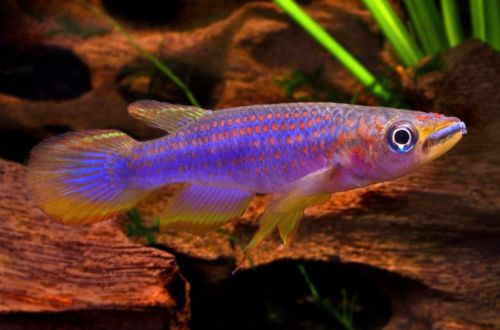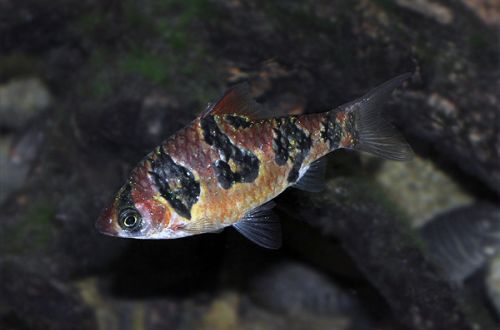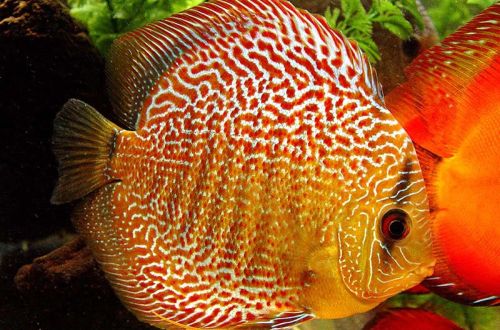
Discus
Discus, scientific name Symphysodon aequifasciatus, belongs to the Cichlidae family. A majestic, graceful fish, often described as the “King of Aquarium Fish”. They are highly regarded throughout the world and have earned the love and devotion of many aquarists due to their exquisite form and regal posture.

The Discus genus has several related species, but a single name is often used in sales to avoid confusion. In addition, there are many color morphological forms that are artificially bred and not found in the wild. The latter are more hardy and better adapted to life in an aquarium than their wild relatives. Fish are more expensive than other tropical species, their maintenance will also require financial costs for good equipment, so not every aquarist can afford it.
Requirements and conditions:
- The volume of the aquarium – from 200 liters.
- Temperature – 28-31°C
- Value pH — 6.0–6.5
- Water hardness – soft (5-10dH)
- Substrate type – any
- Lighting – moderate
- Brackish water – no
- Water movement is weak
- Size – 15–25 cm.
- Nutrition – meat products
- Life expectancy – up to 10 years.
Contents
Habitat
They are widely distributed in the Amazon River basin and its tributaries in the territory of the modern South American countries of Brazil, Peru, Venezuela and Colombia. They live in still or slow moving waters along river banks, where they hide among the tangled roots and branches of coastal trees and shrubs. Feeds on insects and their larvae, aquatic invertebrates
Description
Large fish, reaching a length of 25 cm, have a laterally compressed disc-shaped (flat) body shape. The dorsal and anal fins are almost symmetrical, starting from the middle of the body and closing at the tail. The pectoral fins are thin and long.
Coloring and pattern varies depending on the specific species and breeding form.
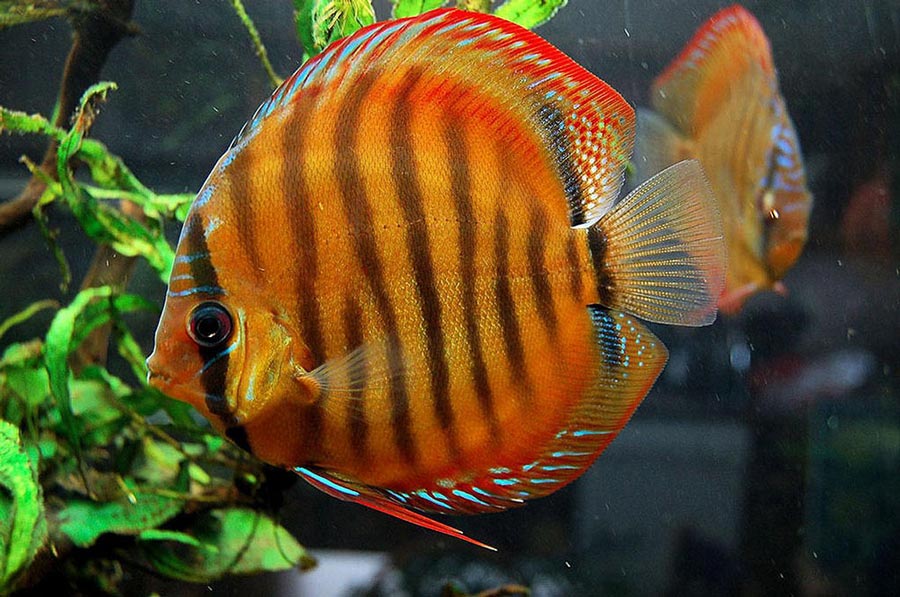
Food
Carnivorous species, prefers live or frozen meat products such as brine shrimp, bloodworms, mosquito larvae, chopped beef heart, etc. It is recommended to use specialized food for Discus, containing all the necessary elements and additives, including vegetable.
Feed 2-3 times a day with the amount of food that will be eaten within 5 minutes. Keep in mind that fish feed slowly and if there are more active neighbors, they may not have enough food. All uneaten leftovers should be removed to prevent water pollution, since meat products, when decomposed, release dangerous substances and provoke the growth of pathogenic bacteria.
Maintenance and care
For such a large fish, you will need a large and spacious tank, get the largest possible, but not less than 200 liters – this will be enough for only one pair. About 25% of the total volume of water should be renewed weekly while cleaning the substrate with a siphon, the new water added should be similar in main parameters: temperature, pH, GH. Work with the siphon carefully, do not make sudden movements, so as not to cause excessive stress to the fish. Diseases caused by stress are typical for them.
At the high temperature that fish need, decay processes (excrement, food debris, fallen pieces of plants) occur quickly, so a productive filtration system will maintain the set water parameters, other mandatory equipment: a heater, an aerator and a lighting system set to moderate light. For newly introduced fish, the lighting should be dimmed for better adaptation.
In the design, it is necessary to provide shelters in the form of grottoes, caves, snags with groups of heat-loving plants that create shaded areas, and free space for swimming.
Social behavior
A peaceful flocking species, prefers a community of at least 6 individuals of its own kind. As neighbors, other peaceful schooling fish that can live in similar conditions and high temperatures (about 30 ° C) are suitable.
Breeding / Reproduction
Breeding at home is quite possible, but the greatest chances exist in a species tank without other fish species. Sexual differences are weakly expressed, but when kept in a flock, this does not matter, the male and female will be able to find themselves and form a pair.
The stimulus for spawning is the establishment of water parameters on the following indicators: temperature within the range of 28–31°C, pH 5.5–6.0, GH 3–10. After some time, a pair of fish or more separates from the flock and occupy one of the sections of the aquarium – this becomes their territory during spawning. The female lays 200 to 400 eggs on plants, driftwood and other decoration items. The fry appear after 60 hours and begin to stay close to their parents. An adult Discus is surrounded by its offspring. In the first week, juveniles feed on a special substance that is secreted on the skin of their parents, and only then they switch to micro-feed (daphnia, cyclops, brine shrimp).
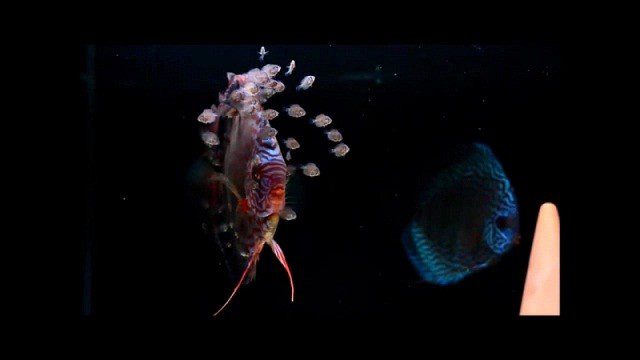
Fish diseases
Under unsuitable conditions, various health problems will inevitably begin to arise, and a similar result causes stress, especially in fish relocated to a new aquarium or purchased from a pet store. For more information on symptoms and treatment methods, see the Aquarium Fish Diseases section.
Features
- Flock keeping at least 6 individuals
- Requires high water quality and high temperature



